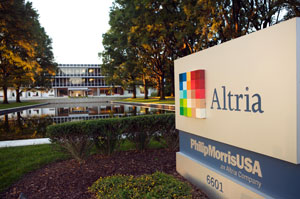Philip Morris International’s cigarette shipment volume during the first quarter of 2017, at 173,552 million, was down by 11.5 percent on that of the first quarter of last year, 196,041 million.
Volume fell in each of the company’s regions: by 7.5 percent to 42,540 million in the EU; by 10.4 percent to 56,574 million in the EEMA (Eastern Europe, Middle East and Asia); by 15.5 percent to 55,142 million in Asia; and by 11.1 percent to 19,296 million in Latin America and Canada
But the company reported, too, a major increase in its shipments of heated tobacco products, which in the first quarter of 2016 amounted to 453 million but which by the first quarter of this year had risen to 4,435 million.
Shipments of heated tobacco products were up from 16 million to 184 million in the EU; from two million to 105 million in the EEMA; and from 435 million to 4,145 million in Asia. In Latin America and Canada, where there had been no shipments of heated tobacco products in the first quarter of 2016, PMI recorded one million in the first quarter of this year.
Shipments of cigarettes and heated tobacco products during the first quarter of 2017, at 177,987 million, were down by 9.4 percent on those of the first quarter of 2016, 196,494 million, with shipments down by 7.1 percent in the EU, by 10.2 percent in the EEMA, by 9.7 percent in Asia, and by 11.1 percent in Latin America and Canada.
‘PMI’s total shipment volume of cigarettes and heated tobacco units decreased by 9.4 percent, or by 7.8 percent excluding net estimated inventory movements, reflecting a challenging comparison with the first quarter of 2016, which declined by a more modest 1.1 percent, as well as ongoing declines of primarily low-price volumes in specific markets, such as
Pakistan and the Philippines,’ the company said in reporting its results. ‘The first quarter of 2016 also benefited from the favorable estimated impact of the leap year.
‘PMI’s cigarette volume decreased by 11.5 percent due to: the EU, principally Italy and Spain, partly offset by Poland; EEMA, mainly North Africa, primarily Egypt and Tunisia, as well as Russia and Ukraine; Asia, principally Indonesia, Japan, Korea, Pakistan and the Philippines; and Latin America & Canada, principally Argentina, Canada and Mexico. ‘The decline in PMI’s cigarette shipment volume was partly offset by higher heated tobacco unit shipment volume of 4.4 billion units, up from 453 million units in the first quarter of 2016, driven by Japan.
Taking cigarette shipments alone, Marlboro shipments of 62,399 million were down by 8.2 percent; L&M shipments of 21,913 million were down by 7.5 percent; Parliament shipments of 9,199 million were down by 9.3 percent; Bond Street shipments of 8,485 million were down by 12.7 percent; Chesterfield shipments of 11,544 million were up by 13.4 percent; Philip Morris shipments of 10,608 million were up by 15.2 percent; and Lark shipments of 6,526 million were up by 0.4 percent. Shipments of other brands, taken together, were down by 26.9 percent to 42,878 million.
PMI said that its reported diluted earnings per share, at $1.02, were up by $0.04 or 4.1 percent on those of the first quarter of 2016.
Adjusted diluted earnings per share, at $0.98, were flat.
Reported net revenues of $16.6 billion were down by 1.4 percent, while net revenues, excluding excise taxes, at $6.1 billion, were down by 0.3 percent.
Reported operating income of $2.4 billion was down by 3.1 percent, while operating companies’ income of $2.5 billion was down by 2.2 percent, and adjusted operating companies’ income of $2.5 billion was down by 2.2 percent.
“Our results were in line with our previously communicated expectation of a relatively weak first quarter, due to lower cigarette volume – primarily related to low-price brands in specific markets where the impact on our profitability was limited – and certain timing factors,” said CEO André Calantzopoulos.
“We are fully on track to deliver our full-year EPS guidance, driven by robust pricing and accelerating IQOS volume growth. We anticipate a combined cigarette and heated tobacco unit volume decline of 3 percent to 4 percent for the full year.
“It is extremely encouraging that already today, despite persistent capacity constraints, 1.8 million consumers have effectively stopped smoking and have switched to our heat-not-burn alternative, IQOS.”











